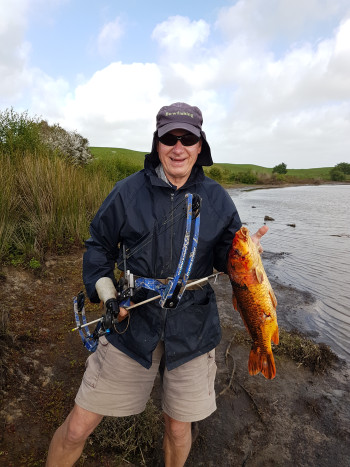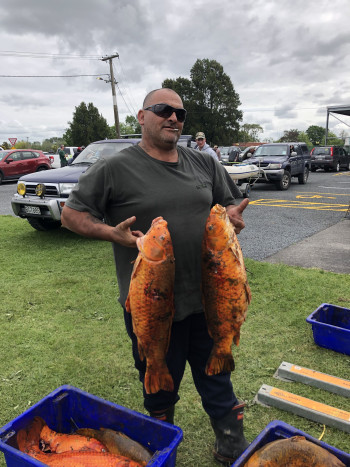“We have bowhunters getting up and over 100 fish a day, and they don’t need a competition to go and do that. It’s a pretty good feeling.”
– Dave Gousmett

Dave Gousmett with koi carp
There’s nothing like introducing a bit of competition to encourage the removal of pest fish from our waterways.
New Zealand Bowhunters Society has just held its 31st Koi Carp Classic, removing over 4.5 tonnes of koi from waterways over the two-day hunting event held within the catchments and lakes systems of the lower Waikato River.
NZ Bowhunters Game Recording Officer Dave Gousmett, pictured, says 62 bowhunters, including a significant number of young and women shooters, came from as far as Australia, the West Coast, Wellington and Dargaville to take part in this year’s competition.
“We had a final tally of 2205 koi carp weighing in at 4.548 tonnes which was our biggest total weight for the competition since 2015,” says Dave, who started the fish shooting passion back in 1988 when the presence of koi in the Waikato was just a rumour.
Koi are now a widespread introduced species which can cause significant damage to the awa and catchments of the Waikato region.
They churn up sediment to impact water quality, eat native aquatic plants species and compete with indigenous fish for food, and being fish in a waterway there are limited control options for their management.
Waikato Regional Council, the Department of Conservation and Te Rui o Waikato (Waikato-Tainui) are working together to on a $1.3 million project, funded by the partners and Waikato River Authority, to trial new methods and research approaches for the control of koi carp in Waikato waterways, including installing carp barriers and supporting community-led action.
In 2021, the council gave NZ Bowhunters $4000 in sponsorship to support koi hunting, including lowering entry fees for participation in the Koi Carp Classic.
The Koi Carp Classic is traditionally held across a weekend in late October to early November when koi are entering their breeding and spawning cycle and can be found congregating in their hundreds.

Dave says the aim of the event is to shoot and kill as many koi as possible from local waterways, using a bow and arrows only, and there are prizes for most carp, heaviest carp and smallest carp.
This year, the heaviest combined weight of koi shot by a team was 749.4 kilograms, or 157 fish; the heaviest koi was 5.84 kilograms and the smallest was 170 grams, which takes some skill in itself to shoot with a bow and arrow. All the fish were collected by Te Riu o Waikato and disposed of at their Hampton Downs processing factory.
“Bow hunters love shooting their bow,” says Dave, and with koi you get to do that a lot.
“We have bowhunters getting up to and over 100 fish a day, and they don’t need a competition to go and do that. It’s a pretty good feeling.”
Over the years of the competition, a total of 41,241 koi have been caught.
Waikato Koi Programme Coordinator Michelle Archer says the bow hunters are an excellent resource when it comes to koi management.
“They are out there fishing all the time and are our eyes and ears, regularly providing sightings to our team to help us understand where koi have spread to.”



To ask for help or report a problem, contact us
Tell us how we can improve the information on this page. (optional)